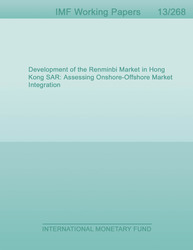
Development of the Renminbi Market in Hong Kong SAR : Assessing Onshore-Offshore Market Integration
Offshore use of the renminbi expanded rapidly in Hong Kong SAR as China sought to develop an international role for its currency while maintaining capital controls. This prompts two questions addressed in this paper: How far advanced is renminbi internationalization? And, what role does Chinese capital account liberalization play? The first is addressed by testing the extent of integration of offshore and onshore markets for the renminbi using a Threshold Autoregression (TAR) model and finds that there are substantial unexploited arbitrage opportunities. A VAR model is used to indentify factors contributing to this limited market integration and finds that capital controls and shifts in global market sentiment explain much of the divergence in onshore and offshore renminbi exchange rates. To address the second question, the paper shows how capital account measures have been used to promote offshore use of the renminbi more actively in the wake of the global financial crisis, but that this was done asymmetrically with controls on inflows eased to a greater extent than on outflows. It concludes that a more balanced liberalization process will sustain progress in renminbi internationalization.
Publication date: December 2013
ISBN: 9781484332948
$18.00
Add to Cart by clicking price of the language and format you'd like to purchase
Available Languages and Formats
| English |
Prices in red indicate formats that are not yet available but are forthcoming.
Topics covered in this book
This title contains information about the following subjects.
Click on a subject if you would like to see other titles with the same subjects.
Insurance - Risk Assessment and Management , offshore financial markets , arbitrage , capital inflows , International Monetary Arrangements and Institutions , Financial Aspects of Economic Integration , Macroeconomic Analyses of Economic Development
Also of interest
Summary
Copyright © 2010 - 2026
Powered by:
AIDC



